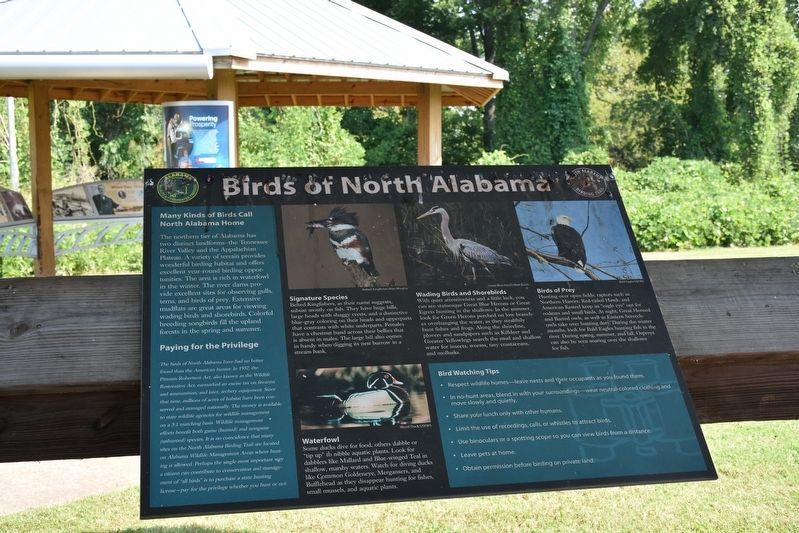Birds of North Alabama
Many Kinds of Birds Call North Alabama Home
The northern tier of Alabama has two distinct landforms-the Tennessee River Valley and the Appalachian Plateau. A variety of terrain provides wonderful birding habitat and offers excellent year-round birding opportunities. The area is rich in waterfowl in the winter. The river dams provide excellent sites for observing gulls, terns, and birds of prey. Extensive mudflats are great areas for viewing wading birds and shorebirds. Colorful breeding songbirds fill the upland forest in the spring and summer.
Paying for the Privilege
The birds of North Alabama have had no better friend than the American hunter. In 1937, the Pitman-Robertson Act , also known as the Wildlife Restoration Act, earmarked and excise tax on firearms and ammunition, and later, archery equipment. Since that time, millions of acres of habitat have been conserved and managed nationally. The money is available to state wildlife agencies for wildlife management on a 3.1 matching basis.
Wildlife management efforts benefit both game (hunted) and nongame (unhunted) species. It is no coincidence that many sites on the North Alabama Birding Trail are located on Alabama Wildlife Management Areas where hunting is allowed. Perhaps the single most important way a citizen can contribute to conservation and management of “all birds” is
Signature Species
Belted Kingfishers as their name suggest, subsist mostly on fish. They have huge bills, large heads with shaggy crest, and a distinctive blue-gray coloring on their heads and upperparts that contrasts with white underparts. Females have a chestnut band across their bellies that is absent in males. The larger bill also comes in handy when digging its nest burrow in a stream bank.
Wading Birds and Shorebirds With quiet attentiveness and a little luck, you can see statuesque Great Blue Herons or Great Egrets hunting in the shallow. In the summer, look for Green Herons perched on low branches overhanging the water, as they stealthily hunt fishes and frogs. Along the shoreline, plovers and sandpipers such as Killdeer and Greater Yellowlegs search the mud and shallow water for insects, worms, tiny crustaceans and mollusks.
Bird of Prey
Hunting over open fields, raptors such as Northern Harrier, Red-Tailed Hawks, and American Kestrel keep an "eagle eye" out for rodents and small birds. At night, Great Horned and Barred owls, as well as Eastern Screech owls take over hunting duty. During the winter months, look for Bald Eagles hunting fish in the river. During the spring, summer,
Waterfowl
Some ducks dive for food, others dabble or "tip up" to nibble aquatic plants. Look for dabblers like Mallard and Blue-Winged Teal in shallow, marshy waters. Watch for diving ducks like Common Goldeneye, Mergansers, and Bufflehead as they disappear hunting for fishes, small mussels, and aquatic plants.
Bird Watching Tips
• Respect wildlife homes-leave nest and their occupants as you found them.
• In no-hunt areas, blend in with your surroundings - wear neutral-colored clothing and move slowly and quietly.
• Share your lunch only with other humans.
• Limit the use of recording, calls, or whistles to attract birds.
• Use binoculars or a spotting scope so you can view birds from a distance.
• Leave pets at home.
• Obtain permission before birding on private lands.
Topics. This historical marker is listed in these topic lists: Animals • Environment. A significant historical year for this entry is 1937.
Location. 34° 47.585′ N, 87° 37.575′ W. Marker is in Muscle Shoals, Alabama, in Colbert County. Marker can be reached from Reservation Road. Marker is located at TVA's Wilson Dam's Visitor Center Bird Kiosk near the Power Station. Touch for map. Marker is in this post office area: Muscle Shoals AL 35661, United States of America. Touch for directions.
Other nearby markers. At least 8 other markers are within
Also see . . .
1. Belted Kingfisher. Habitat Kingfishers live near streams, rivers, ponds, lakes, and estuaries. They nest in burrows that they dig into soft earthen banks, usually adjacent to or directly over water. Kingfishers spend winters in areas where the water doesn’t freeze so that they have continual access to their aquatic foods. (Submitted on July 27, 2017, by Sandra Hughes Tidwell of Killen, Alabama, USA.)
2. Great Blue Heron. Habitat Look for Great Blue Herons in saltwater and freshwater habitats, from open coasts, marshes, sloughs, riverbanks, and lakes to backyard goldfish ponds. They also forage in grasslands and agricultural fields. Breeding birds gather in colonies or “heronries” to build stick nests high off the ground. (Submitted on July 27, 2017, by Sandra Hughes Tidwell of Killen, Alabama, USA.)
3. Great Egrets. Habitat You’ll find Great Egrets in both freshwater and saltwater habitats. They are colonial nesters, typically placing stick nests high in trees, often on islands that are isolated from mammalian predators such as raccoons. (Submitted on July 27, 2017, by Sandra Hughes Tidwell of Killen, Alabama, USA.)
4. Northern Harrier. Habitat Northern Harriers breed in wide-open habitats ranging from Arctic tundra to prairie grasslands to fields and marshes. Their nests are concealed on the ground in grasses or wetland vegetation. In migration and winter, harriers typically move south away from areas that receive heavy snow cover, ending up in open habitats similar to those in which they breed. (Submitted on July 27, 2017, by Sandra Hughes Tidwell of Killen, Alabama, USA.)
5. Red-tailed Hawk. Habitat The Red-tailed Hawk is a bird of open country. Look for it along fields and perched on telephones poles, fenceposts, or trees standing alone or along edges of fields. (Submitted on July 27, 2017, by Sandra Hughes Tidwell of Killen, Alabama, USA.)
6. American Kestrel. Habitat American Kestrels occupy habitats ranging from deserts and grasslands to alpine meadows. You’re most likely to see them perching on telephone wires along roadsides, in open country with short vegetation and few trees. (Submitted on July 27, 2017, by Sandra Hughes Tidwell of Killen, Alabama, USA.)
7. Mallard. Habitat Mallards can live in almost any wetland habitat, natural or artificial. Look for them on lakes, ponds, marshes, rivers, and coastal habitats, as well as city and suburban parks and residential backyards. (Submitted on July 27, 2017, by Sandra Hughes Tidwell of Killen, Alabama, USA.)
8. Great Horned Owl. Habitat Look for this widespread owl in woods, particularly young woods interspersed with fields or other open areas. The broad range of habitats they use includes deciduous and evergreen forests, swamps, desert, tundra edges, and tropical rainforest, as well as cities, orchards, suburbs, and parks. (Submitted on July 27, 2017, by Sandra Hughes Tidwell of Killen, Alabama, USA.)
9. Barred Owl. Habitat Barred Owls live in large, mature forests made up of both deciduous trees and evergreens, often near water. They nest in tree cavities. In the Northwest, Barred Owls have moved into old-growth coniferous forest, where they compete with the threatened Spotted Owl. (Submitted on July 27, 2017, by Sandra Hughes Tidwell of Killen, Alabama, USA.)
10. Eastern Screech-Owl. Habitat Trees define the Eastern Screech-Owl’s habitat. This owl is fairly common in most types of woods (evergreen or deciduous; urban or rural), particularly near water. It shuns treeless expanses of mountains or plains. (Submitted on July 27, 2017, by Sandra Hughes Tidwell of Killen, Alabama, USA.)
11. Killdeer. Habitat Look for Killdeer on open ground with low vegetation (or no vegetation at all), including lawns, golf courses, driveways, parking lots, and gravel-covered roofs, as well as pastures, fields, sandbars and mudflats. This species is one of the least water-associated of all shorebirds. (Submitted on July 27, 2017, by Sandra Hughes Tidwell of Killen, Alabama, USA.)
12. Greater Yellowlegs. Adult Description Medium-sized to large shorebird. Long, bright yellow legs. Rather long neck and bill. White rump and tail. Immature Description Similar to adult, but less heavily marked. (Submitted on July 27, 2017, by Sandra Hughes Tidwell of Killen, Alabama, USA.)
Credits. This page was last revised on June 5, 2020. It was originally submitted on July 27, 2017, by Sandra Hughes Tidwell of Killen, Alabama, USA. This page has been viewed 486 times since then and 47 times this year. Last updated on June 5, 2020, by Jade Dyer of Ventura, Usa. Photos: 1, 2. submitted on July 27, 2017, by Sandra Hughes Tidwell of Killen, Alabama, USA. • J. Makali Bruton was the editor who published this page.

